现代材料学考试试题2010
现代材料分析方法(英文)
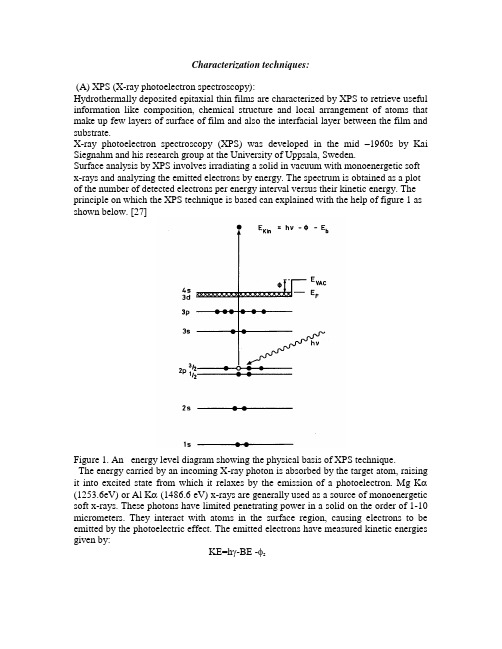
Characterization techniques:(A) XPS (X-ray photoelectron spectroscopy):Hydrothermally deposited epitaxial thin films are characterized by XPS to retrieve useful information like composition, chemical structure and local arrangement of atoms that make up few layers of surface of film and also the interfacial layer between the film and substrate.X-ray photoelectron spectroscopy (XPS) was developed in the mid –1960s by Kai Siegnahm and his research group at the University of Uppsala, Sweden.Surface analysis by XPS involves irradiating a solid in vacuum with monoenergetic soft x-rays and analyzing the emitted electrons by energy. The spectrum is obtained as a plot of the number of detected electrons per energy interval versus their kinetic energy. The principle on which the XPS technique is based can explained with the help of figure 1 as shown below. [27]Figure 1. An energy level diagram showing the physical basis of XPS technique.The energy carried by an incoming X-ray photon is absorbed by the target atom, raising it into excited state from which it relaxes by the emission of a photoelectron. Mg Kα(1253.6eV) or Al Kα (1486.6 eV) x-rays are generally used as a source of monoenergetic soft x-rays. These photons have limited penetrating power in a solid on the order of 1-10 micrometers. They interact with atoms in the surface region, causing electrons to be emitted by the photoelectric effect. The emitted electrons have measured kinetic energies given by:KE=hγ-BE -φsWhere hγ is the energy of the photon, BE is the binding energy of the atomic orbital from which the electron originates and φs is the spectrometer work function. The binding energy may be regarded as the energy difference between the initial and final states after the photoelectron has left the atom. Because there are a variety of possible final states of the ions from each type of atom, there is corresponding variety of kinetic energies of the emitted electrons. Photoelectrons are emitted from all energy levels of the target atom and hence the electron energy spectrum is characteristic of the emitting atom type and may be thought as its XPS fingerprint. Each element has unique spectrum .The spectrum from a mixture of elements is approximately the sum of peaks of the individual constituents. Because the mean free path of electrons in the solids is very small, the detected electrons originate from only the top few atomic layers making XPS a unique surface sensitive technique for chemical analysis. Quantitative data can be obtained from peak heights or peak areas and identification of chemical states often can be made from exact measurement of peak positions and separations as well from certain spectral features.The line lengths indicate the relative probabilities of the various ionization processes. The p,d and f levels split upon ionization leading to vacancies in the p1/2,p3/2,d3/2,d5/2,f5/2 and f7/2.The spin orbit splitting ratio is 1:2 for p levels ,2:3 for d levels and 3:4 for f levels .Because each element has a unique set of binding energies, XPS can be used to identify and determine the concentration of the elements in the surface. Variations in the elemental binding energies (the chemical shifts) arise from the differences in the chemical potential and polarizibilty of compounds. These chemical shifts can be analyzed to identify the chemical state of the materials being analyzed.The electrons leaving sample are detected by an electron spectrometer according to their kinetic energy. The analyzer is usually operated as an energy window, referred to as pass energy. To maintain a constant energy resolution, the pass energy is fixed. Incoming electrons are adjusted the pass energy before entering the energy analyzer. Scanning for different energies is accomplished by applying a variable electrostatic field before the analyzer. This retardation voltage may be varied from zero upto and beyond the photon energy. Electrons are detected as discrete events, and the number of electrons for the given detection time. And energy is stored and displayed.In general, the interpretation of the XPS spectrum is most readily accomplished first by identifying the lines that almost always present (specifically those of C and O), then by identifying major lines and associated weaker lines.(B) Auger electron spectroscopy:Auger electron spectroscopy is a very useful technique in elemental characterization of thin films. In the current project this technique has been utilized not only for elemental compositional analysis but also for understanding nucleation and growth mechanism. Auger electron effect is named after the French physicist Pierre Auger who described the process involved in 1925.Auger is process is bit more complicated than the XPS process.The Auger process occurs in three stages. First one being atomic ionization. Second being electron emission (Auger emission) and third being analysis of emitted auger electrons .The source of radiation used is electrons that strike in the range of 2 to 10 kev. The interatomic process resulting in the production of an Auger electron is shown in figure 2 below.Figure 2 showing the interatomic process resulting in production of the Auger electrons. One electron falls a higher level to fill an initial core hole in the k-shell and the energy liberated in this process is given to second electron ,fraction of this energy is retained by auger electron as kinetic energy.X-ray nomenclature is used for the energy levels involved and the auger electron is described as originating from for example ,an ABC auger transition where A is the level of the original core hole,B is the level from which core hole was filled and C is the level from which auger electron was emitted. In above figure 2 shown above the auger transition is described as L3M1M2, 3.The calculation of energies of the lines in the Auger electron spectrum is complicated by the fact that emission occurs from an atom in an excited state and consequently the energies of the levels involved are difficult to define precisely.Each element in a sample being studied gives rise to characteristic spectrum of peaks at various kinetic energies. Area generally scanned is 1 mm2.To understand the variation in the concentration with the distance from the surface depth profiling can also be carried out. For depth profiling the surface has to be etched away by using argon beam.The principle advantage that AES hold over XPS is that the source of excitation in case of AES is electrons which allows it to take a spectra from micro-regions as small as 100 nm diameters or less instead of averaging over the whole of the surface of the sample as is done generally in XPS.(C) Atomic force Microscope:Atomic Force Microscope (AFM ) is being used to solve processing and materials problems in a wide range of technologies affecting the electronics, telecommunications, biological, chemical, automotive, aerospace, and energy industries. The materials being investigating include thin and thick film coatings, ceramics, composites, glasses, synthetic and biological membranes, metals, polymers, and semiconductors.In the current work AFM was used to understand the nucleation and growth mechanism of the epitaxial thin films and to understand the surface morphology of totally grown films in terms of surface coverage and surface roughness.In the fall of 1985 Gerd Binnig and Christoph Gerber used the cantilever to examine insulating surfaces. A small hook at the end of the cantilever was pressed against the surface while the sample was scanned beneath the tip. The force between tip and sample was measured by tracking the deflection of the cantilever. This was done by monitoring the tunneling current to a second tip positioned above the cantilever. They were able to delineate lateral features as small as 300 Å. This is the way force microscope was developed. Albrecht, a fresh graduate student, who fabricated the first silicon microcantilever and measured the atomic structure of boron nitride. The tip-cantilever assembly typically is microfabricated from Si or Si3N4. The force between the tip and the sample surface is very small, usually less than 10-9 N.According to the interaction of the tip and the sample surface, the AFM is classified as repulsive or Contact mode and attractive or Noncontact mode. In contact mode the topography is measured by sliding the probe tip across the sample surface. In noncontact mode, topography is measured by sensing Van de Waals forces between the surface and probe tip. Held above the surface. The tapping mode which has now become more popular measures topography by tapping the surface with an oscillating probe tip which eliminates shear forces which can damage soft samples and reduce image resolution. 1. Laser2. Mirror3. Photo detector4. Amplifier5. Register6. Sample7. Probe8. CantileverFigure 3 showing a schematic diagram of the principle of AFM.Compared with Optical Interferometric Microscope (optical profiles), the AFM provides unambiguous measurement of step heights, independent of reflectivity differences between materials. Compared with Scanning Electron Microscope, AFM provides extraordinary topographic contrast direct height measurements and unobscured views of surface features (no coating is necessary). One of the advantages of the technique being that it can be applied to insulating samples as well. Compared with Transmission Electron Microscopes, three dimensional AFM images are obtained without expensive sample preparation and yield far more complete information than the two dimensional profiles available from cross-sectioned samples.(D) Fourier Transform Infrared Spectroscopy:Infrared spectroscopy is widely used chemical analysis tool which in addition to providing information on chemical structures also can give quantitative information such as concentration of molecules in a sample.The development in FTIR started with use of Michelson interferometer an optical device invented in 1880 by Albert Abraham Michelson. After many years of difficultiesin working out with time consuming calculations required for conversion intereferogram into spectrum, the first FTIR was manufactured by the Digilab in Cambridge Massachusetts in 1960s .These FTIR machines stared using computers for calculating fourier transforms faster.The set up consists of a source, a sample and a detector and it is possible to send all the source energy through an interferometer and onto the sample. In every scan, all source radiation gets to the sample. The interferometer is a fundamentally different piece of equipment than a monochromater. The light passes through a beamsplitter, which sends the light in two directions at right angles. One beam goes to a stationary mirror then back to the beamsplitter. The other goes to a moving mirror. The motion of the mirror makes the total path length variable versus that taken by the stationary-mirror beam. When the two meet up again at the beamsplitter, they recombine, but the difference in path lengths creates constructive and destructive interference: an interferogram:The recombined beam passes through the sample. The sample absorbs all the different wavelengths characteristic of its spectrum, and this subtracts specific wavelengths from the interferogram. The detector reports variation in energy versus time for all wavelengths simultaneously. A laser beam is superimposed to provide a reference for the instrument operation.Energy versus time was an odd way to record a spectrum, until the point it was recognized that there is reciprocal relationship between time and frequency. A Fourier transform allows to convert an intensity-vs.-time spectrum into an intensity-vs.-frequency spectrum.The advantages of FTIR are that all of the source energy gets to the sample, improving the inherent signal-to-noise ratio. Resolution is limited by the design of the interferometer. The longer the path of the moving mirror, the higher the resolution.One minor drawback is that the FT instrument is inherently a single-beam instrument and the result is that IR-active atmospheric components (CO2, H2O) appear in the spectrum. Usually, a "Background" spectrum is run, and then automatically subtracted from every spectrum.(E) Scanning Electron Microscopy:Scanning electron microscopy is one the most versatile characterization techniques that can give detailed information interms of topography, morphology, composition and crystallography. This has made it widely useful in thin film characterization.The scanning electron microscope is similar to its optical counterparts except that it uses focused beam of electrons instead of light to image the specimen to gain information about the structure and composition.A stream electron is accelerated towards positive electrical potential. This stream is confined and focused using metal apertures and magnetic lenses into a thin, focused, monochromatic beam. This beam is focused onto the sample using a magnetic lens. Interactions occur inside the irradiated sample, affecting the electron beam. These interactions and effects are detected and transformed into an image. The electron detector collects the electrons and then image is created. Scanning with SEM is accomplished bytwo pairs of electromagnetic coils located within the objective lens, one pair deflects the beam in x-direction across the sample and the other pair deflects it in the y direction. Scanning is controlled by applying an electric signal to one pair of scan coils such that the electron beam strikes the sample to one side of theFigure 4 Schematic view of a SEM instrument.center axis of the lens system. By varying the electrical signal to this pair of coils as a function of time, the electron beam is moved in a straight line across the sample and then returned to its original position. Thus by rapidly moving the beam the entire sample surface can be irradiated with the electron beam. The output signal consists of backscattered and secondary electrons which generally serve as basis of scanning electron microscope and whereas the x-ray emission serves as the basis of the energy dispersive spectroscopy as shown in figure 4.Figure 5.Schematic presentation of the interaction of the electron with the sample.Energy dispersive spectroscopy is analytical method which is used in determination of elemental composition of the specimen.EDS uses the electrons generated characteristic x-radiation to determine elemental composition. The SEM/EDS combination is a powerful tool in inorganic microanalysis, providing the chemical composition of volumes as small as 3 m3.(F) Transmission Electron microscopy:Transmission electron microscopy was used to analyze the interface between the BaTiO3 on SrTiO3 single crystals.For TEM specimen must be specially prepared to thicknesses which allow electrons to transmit through the sample, much like light is transmitted through materials in conventional optical microscopy. Because the wavelength of electrons is much smaller than that of light, the optimal resolution attainable for TEM images is many orders of magnitude better than that from a light microscope. Thus, TEMs can reveal the finest details of internal structure - in some cases as small as individual atoms. Magnifications of 350,000 times can be routinely obtained for many materials, whilst in special circumstances; atoms can be imaged at magnifications greater than 15 million timesThe energy of the electrons in the TEM determine the relative degree of penetration of electrons in a specific sample, or alternatively, influence the thickness of material from which useful information may be obtained.Cross-sectional specimens for TEM observation of the interface between the film and the substrate were prepared by conventional techniques employing mechanical polishing, dimpling and ion beam milling.TEM column is shown in figure 6 consists of gun chamber on the top to the camera at the bottom everything is placed under vacuum.Figure 6. Main components of TEM system. [28]At the top of the TEM column is the filament assembly, which is connected to thehigh voltage supply by insulated cable. In standard TEM, normal accelerating voltagesranges from 20,000 to 100,000V.Intermediate-voltage and high voltage TEMs may use accelerating voltages of 200,000 V to 1000000 V.The higher the accelerating voltage, the greater the theoretical resolution. Below the filament tip and above it the anode is a beam volume called crossover. In this area of the filament chamber, the electron beam volume iscondensed to its highest density. There are more electrons per unit area at the cross over than at any other place in the microscope. Crossover is the effective electron source for image formation. In a TEM, the diameter of the electron beam at crossover is approximately 50 μm.The anode or positively charged plate, is below the filament assembly.Electron beam then travels to the condenser –lens system.TEMs has two condensers lenses. Condenser system lens system controls electron illumination on the specimen and on the viewing screen for such functions as viewing, focusing and photography. Condenserlenses are fitted with apertures which are usually small platinum disks or molybdenum strips with holes of various sizes ranging from 100 to 400 μm and it protects specimen from too many stray electrons which can contribute to excessive heat and limit X-ray production farther down the columnObjective lens is the first magnifying lens and the specimen is inserted into the objective lens, which must be designed so that the specimen can be moved in both X and Y directions and have tilting and rotating capabilities. As the electron beam interacts with the specimen, a number of signals useful in the formation of the TEM image occur: absorption, diffraction, elastic scattering and inelastic scattering.(H) X-ray Diffraction (XRD):X-ray diffraction is the most commonly known technique which I used to determination of the phase formed in films and also to assess texture and crystallinity.X-rays were discovered in 1895 by the German physicist Wilhelm Conrad Röntgen - in some languages x-rays are called Röntgen-rays - and x-ray diffraction was discovered in 1912.The X-rays used in diffraction experiments all have a wavelength of 0.5-2.5 Å. The intensity of a beam of x-rays is the rate of transport of energy flow through a unit area perpendicular to the direction of propagation. To produce x-rays, a source of electrons, a high accelerating voltage and a target are needed. To get the voltage, the metal target is grounded and a cathode is at 30-50 kV. To get the electrons a metal filament is resistively heated (the tube is called a filament tube). The filament current is 3-5 amps. The cathode and the filament is one and the same thing and surrounding the target and the filament is an air evacuated envelope.The electrons from the filament are accelerated towards the target. They bombard the target in a rectangular shaped area called the focal spot. From there the x-rays are emitted in all directions. The walls of the tube are impenetrable for the x-rays except where beryllium windows are inserted. Beryllium has a very low absorption coefficient for the x-rays.The amount of x-rays produced depends on the number of electrons emitted and their energy when they reach the target. The number of electrons in turn depends on the filament temperature, and thus the filament current. The current of electrons from the filament to the target is measurable and usually 25-55 mA. This current can be chosen freely as a feedback loop will feed the filament with the current needed. The energy ofthe electrons depend on the accelerating voltage. Thus the total intensity emitted by thex-ray tube depends on both the operating voltage and the tube current.In general, diffraction is possible when the length of the wave is of the same order of magnitude as the distance between the regularly spaced scattering objectsTwo scattered rays are in phase, if their path difference is equal to a whole number n of wavelengths. Scattered rays emerging from a plane surface as a result of a beam incident on that surface, have a path difference equal to a whole number of wavelengths, if n l = 2 d' sinq (The Bragg Law),where d' is the distance between the diffracting planes in the crystal and q is the angle between the incident beam and the surface. n is the order of reflection and n can be any integral number as long as sin q < 1. n is also equal to the number of wavelengths in the path difference of two rays scattered from adjacent planes (e.g. If n = 2 then a ray scattered from one plane will have a path that is two wavelengths shorter than a ray scattered from a deeper lying neighbor plane).The basis for phase analysis is that the crystal of a certain phase will have interatomic distances peculiar to that phase and these different distances will cause a series of reflections as the detector are shifted through 2theta.Two phases can have similar or almost similar structures and hence interatomic distances. This makes identifying phases in an unknown sample very difficult, but knowing what elements are present in the sample will narrow the possibilities down quite a bit. Also crystallite size using XRD .X-ray pole figure measurements are used to characterize the film with respect to any preferred orientation with which growth has taken place. Rocking curve is another application to characterize the film with respect to its quality ofcrystallinity comparing to the single crystals or polycrystalline materials.。
党课考试经典试题

2010年党员考试试题1、中国共产党是中国工人阶级的先锋队,同时是中国人民和中华民族的先锋队,是中国特色社会主义事业的领导核心,代表中国先进生产力的发展要求,代表中国先进文化的前进方向,代表中国最广大人民的根本利益。
党的最高理想和最终目标是实现共产主义。
2、中国共产党以马克思列宁主义、毛泽东思想、邓小平理论和“三个代表”重要思想作为自己的行动指南。
3、中国共产党坚持独立自主的和平外交政策。
4、第29届夏季奥运会将于2008年8月8日在北京举办。
5、我们党的最大政治优势是密切联系群众,党执政后的最大危险是脱离群众。
6、解放思想是发展中国特色社会主义的一大法宝,改革开放是发展中国特色社会主义的强大动力,科学发展、社会和谐是发展中国特色社会主义的基本要求,全面建设小康社会是党和国家到2020年的奋斗目标,是全国各族人民的根本利益所在。
7、科学发展观,第一要义是发展,核心是以人为本,基本要求是全面协调可持续,根本方法是统筹兼顾。
8、科学发展、社会和谐是发展中国特色社会主义的基本要求。
9、党的根本宗旨是全心全意为人民服务。
10、邓小平理论是马克思列宁主义的基本原理同当代中国实践相结合的产物,是毛泽东思想在新的历史条件下的继承和发展,是马克思列宁主义在中国发展的新阶段,又是当代中国的马克思主义。
11、“三个代表”重要思想是对马克思列宁主义、毛泽东思想、邓小平理论的继承和发展,反映了当代世界和中国的发展变化对党和国家工作的新要求,是加强和改进党的建设、推进我国社会主义自我完善和发展的强大理论武器,是中国共产党集体智慧的结晶,是党必须长期坚持的指导思想。
12、始终做到“三个代表”,是我们党的立党之本、执政之基、力量之源。
13、根据党章的规定,年满十八岁的中国工人、农民、军人、知识分子和其他社会阶层的先进分子,承认党的纲领和章程,愿意参加党的一个组织并在其中积极工作、执行党的决议和按期交纳党费的,可以申请加入中国共产党。
2010年辽宁大连市初中毕业升学考试语文试题(新增答案)

大连市2010年初中毕业升学考试语文注意事项:1.请在答题卡上作答,在试卷上作答无效。
2.本试卷共四大题,25小题,满分150分。
考试时间150分钟。
一、积累与运用(28分)1.请用正楷字将下面的汉字抄在田字格里,要求书写规范、端正、整洁。
(2分)镇定自若运筹帷幄2.给加点的字注音,依据拼音填写汉字。
(4分)(1)匀称.(2)蹲.踞(3)润如油(gāo)(4)大(chè)大悟3.在有语病的地方画横线,并写出修改意见。
(2分)为弘扬中华民族传统文化,增加学生的国学素养,我校将开展古诗文背诵活动。
4.下列关于作家、作品的表述,错误..的一项是()(2分)A.宗璞的散文《紫藤萝瀑布》和冰心的散文《谈生命》,都表达了作者对生命的独特体验。
B.范仲淹,北宋政治家、文学家,他的《醉翁亭记》,表达了“先天下之忧而忧,后天下之乐而乐”的济世情怀。
C.从表达方式角度,诗歌可分为叙事诗和抒情诗。
北朝民歌《木兰诗》和唐代诗人杜甫的《石壕吏》都是叙事诗。
D.吴敬梓的《范进中举》、契诃夫的《变色龙》均使用夸张、对比等讽刺小说常用的手法,塑造了性格鲜明的人物形象。
5.仿照下面句子续写一句话。
(2分)假如我是一个诗人,我就要用动情的诗篇,来讴歌大海的波澜壮阔;,,。
6.默写填空。
(10分)(1)小大之狱,,。
(《曹刿论战》)(2),。
寂寞梧桐深院锁清秋。
(李煜《相见欢》)(3)北国风光,,。
(毛泽东《沁园春·雪》)(4)李白在《渡荆门送别》中描写月映水中、云霞飘飞的诗句是,。
(5)诗人总能从大自然生生不息的规律中得到启发:朱熹面对一池碧水,感悟“问渠那得清如许?为有源头活水来”;龚自珍凝视一地花瓣,顿悟“,”。
7人物评价角度人物形象相关情节概括外祖父(《童年》)正面母亲改嫁时,外祖父教导我要学会自立。
反面林冲(《水浒传》)正面侠肝义胆反面二、古诗文阅读(16分)(一)从小丘西行百二十步,隔簧竹,闻.水声,如鸣佩环,心乐之。
初三政治月考考试试题及答案
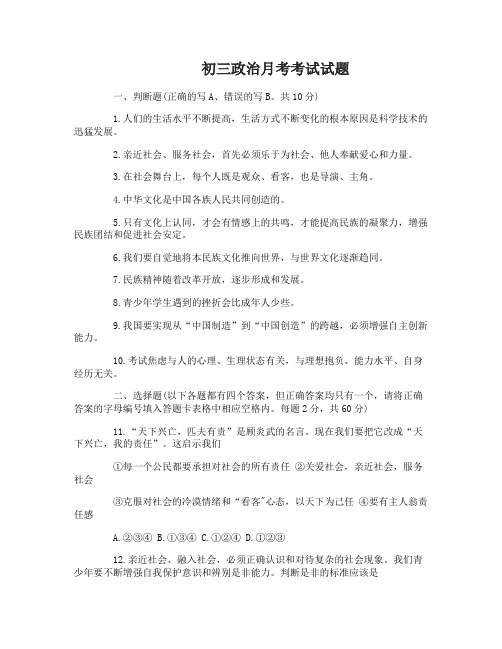
初三政治月考考试试题一、判断题(正确的写A、错误的写B。
共10分)1.人们的生活水平不断提高,生活方式不断变化的根本原因是科学技术的迅猛发展。
2.亲近社会、服务社会,首先必须乐于为社会、他人奉献爱心和力量。
3.在社会舞台上,每个人既是观众、看客,也是导演、主角。
4.中华文化是中国各族人民共同创造的。
5.只有文化上认同,才会有情感上的共鸣,才能提高民族的凝聚力,增强民族团结和促进社会安定。
6.我们要自觉地将本民族文化推向世界,与世界文化逐渐趋同。
7.民族精神随着改革开放,逐步形成和发展。
8.青少年学生遇到的挫折会比成年人少些。
9.我国要实现从“中国制造”到“中国创造”的跨越,必须增强自主创新能力。
10.考试焦虑与人的心理、生理状态有关,与理想抱负、能力水平、自身经历无关。
二、选择题(以下各题都有四个答案,但正确答案均只有一个,请将正确答案的字母编号填入答题卡表格中相应空格内。
每题2分,共60分)11.“天下兴亡,匹夫有责”是顾炎武的名言。
现在我们要把它改成“天下兴亡,我的责任”。
这启示我们①每一个公民都要承担对社会的所有责任②关爱社会,亲近社会,服务社会③克服对社会的冷漠情绪和“看客"心态,以天下为己任④要有主人翁责任感A.②③④B.①③④C.①②④D.①②③12.亲近社会、融入社会,必须正确认识和对待复杂的社会现象。
我们青少年要不断增强自我保护意识和辨别是非能力。
判断是非的标准应该是A.能否带来经济利益B.个人的好恶C.道德和法律规范D.别人的评价和意见1 3.下列观点错误的是A.小明说:“我们在搞好学习的同时,还要胸怀天下,承担起关爱社会的责任。
”B.国家处在困难时刻,最能考验公民的责任意识C.我们青少年肩负着铸造民族辉煌的责任D.小伟说:“参加公益活动、服务社会是大人们的事,与我们初中生无关。
”14.伟大诗人歌德曾说过:“你若要人喜欢你的价值,你就得给人创造价值。
”理解错误的是A.只有积极主动亲近社会、服务社会,才能发挥自己的智慧和力量B.在奉献社会的过程中,实现自身的人生价值C.要认识到自己扮演的角色,尽到自己的责任D.对自己可以不承担责任,对社会要承担责任15.《三代人赶集》从一侧面反映出:________。
2010届录取汇总表
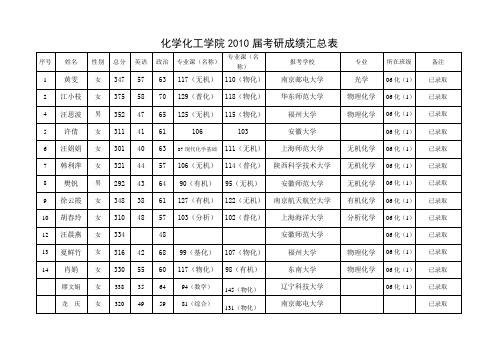
南京理工大学
应用化学
06材化
21
冯刚
男
354
64
61
90(综合)
139(物化)
北京理工大学
化学专业
06材化
已录取
22
龚洁
女
366
52
64
124(物化)
126(有机)
南京邮电大学
有机化学
06材化
已录取
23
吴世昌
男
285
30
64
57(数学)
134(材科)
四川大学
材料学
06材化
化学化工学院2010届考研成绩汇总表
53
71
微生物与生物化学
190药学综合
第四军医大学
药学
06材化
已录取
3
徐玉红
女
307
54
68
74(数学)
111(有机)
合肥工业大学
食品科学
06材化
已录取
4
桂清文
男
364
49
70
134(有机)
111(物化)
湖南大学
有机化学
06材化
已录取
5
刘皓
男
363
63
67
100(物化)
133(分析)
中科大
分析化学
06材化
华东理工大学
有机化学
06化(2)
已录取
4
江强
男
286
46
72
57(数学)
111(物化)
上海工程科技大学
能源化工
06化(2)
已录取
5
方丽
辽宁省重点高中沈阳市郊联体2024-2025学年高三上学期期中考试语文试题(含答案)

辽宁省重点高中沈阳市郊联体2024—2025学年度上学期期中考试高三年级试题语文第I卷阅读题(共70分)一、现代文阅读(35分)(一)现代文阅读I(本题共5小题,19分)阅读下面的文字,完成1~5小题。
材料一:94岁的艺术大师黄永玉上台给比自己小整整30岁的故宫博物院院长单霁翔颁奖。
“故宫很具体,走遍9000多座房屋,1200多座建筑,每天沿着宫墙走一圈,踩破20双布鞋。
”这是2018年12月15日“影响中国”2018年度人物荣誉盛典上的一幕。
故宫博物院院长单霁翔荣获年度文化人物。
2012年年初,故宫正处于低潮。
深陷失窃、会所、错字、拍卖、封口、瞒报、逃税等“十重门”。
58岁的单霁翔临危受命,被任命为故宫博物院新院长。
大家都很关心新官上任会有哪三把火,单霁翔却笑言:我一把火都没有,因为故宫古建筑群最怕火。
上任伊始,单霁翔穿着一双老布鞋,带着助理,绕着故宫走了一圈儿。
故宫的1200多座建筑,9371间房屋,凡是门都要推开看一看。
从位于神武门西边的院长办公室出门向西,沿故宫红墙逆时针行走一圈大约4公里。
自2012年年初担任故宫博物院院长至今的每个工作日,这样的例行巡查已经让单霁翔走坏了20多双布鞋。
大夏天,助理脖子上挎着相机,吭哧吭哧跟着跑,偷偷抱怨:“跟着我们院长,费鞋。
”故宫收藏着众多文物,鲜有人能够将其数得一清二楚,但单霁翔做到了。
他可以将文物数量精确到个位数:1862690件(套),这是2016年年底的数据。
(摘编自《故宫,你怎么变成这样了?》)材料二:对于几个世纪前的外国人来说,进入古老的东方帝国——中国的宫廷甚至面见皇帝,是一件相当不易的事情。
意大利传教士利玛窦一到中国,就将此作为自己最大的目标。
在中国生活了接近二十年后,他才终于得到机会,一睹紫禁城真容。
利玛窦在札记中记录,他们被召入一间大殿,“看上去足可容纳三万人,是一座壮丽的皇家建筑,大殿的另一端,有一个顶部高拱的房间,有五扇大门,通向皇帝的起居室。
2010年山东省普通高考试卷各科试卷及答案

挥空间的同时,又设定了一定限制,即围绕“人生”生发感想、展开联想,这样既避免了原先话题作文过于 宽泛不着边际的弊端,也在一定程度上克服了某些命题作文限制过于严格的不足。从文体选择的角度看, 考生可记叙、可议论,或描写、或抒情,也可以多种表达方式综合运用。这样,有利于展示考生的实际写 作水平,更充分地体现高考的选拔功能。特别是,题目选择文学经典作品中富于哲理意味的名句,涉及人 生、人生态度等重大问题,有助于帮助学生确立正确的人生态度,也符合新课程标准和考试大纲对学生情 感态度和价值观的培养目标。既能促使学生在学习和生活中多方面积累材料,也能鼓励有个性、有创意的 表达,提高思辨和审美能力,还能引导他们在表达实践中发展形象思维、逻辑思维和创造性思维,这些对 学生形成健康向上的价值观念和高尚的道德情操产生积极的影响,对中学作文教学都会产生良好的导向作
ht t p ://
ht t p ://hot
质和基本理念,2008年的话题作文“春来草自青”在体现新课程性质和理念方面又有新的提升。2009年高考 作文不再采用话题作文的形式,而是要求直接以“见证”为题进行写作,降低了对考生思维的限制,更方便 考生把握方向确定立意。 2010年高考作文在考试形式上又做了适度创新,选取俄国文学大家列夫?托尔斯泰《安娜?卡列尼娜 》中的一句话“人生的一切变化,一切魅力,一切美都是由光明和阴影构成的”作为材料,要求考生根据阅 读后的感悟和联想作文。由于所选材料内涵较为丰富,考生在理解上可以体现出不同的层次,如人生的复 杂多样和丰富多彩,人生的魅力和美来自于生活的复杂和变化,光明和阴影相互依存相互作用的辩证关
材料工程考试试题

材料工程考试试题
1. 请简述金属材料的几种常见腐蚀形式及其防护方法。
2. 解释金属疲劳的概念,列举几个影响疲劳寿命的因素,并提出相应改善措施。
3. 说明复合材料的定义及其在航空航天领域的应用情况。
4. 简要介绍热处理工艺在金属材料中的作用和意义,并举例说明。
5. 分析塑料材料的特性、加工方式和应用范围,并比较与金属材料的异同点。
6. 论述纳米材料在材料科学中的研究进展和应用前景。
7. 就材料表面处理技术的分类、原理及优点进行详细描述,并选取一种技术进行深入分析。
8. 请写出几种常见的非金属材料及其优缺点,以及在工程应用中的具体案例。
9. 介绍玻璃材料的种类及其物理化学性质,以及在建筑、容器等领域中的应用。
10. 阐述材料设计的概念和原则,指出在产品设计过程中合理选用材料的重要性。
以上是本次材料工程考试题目,请根据各题要求深入思考并作出详细回答。
祝您顺利通过考试!。
概论试卷二和答案
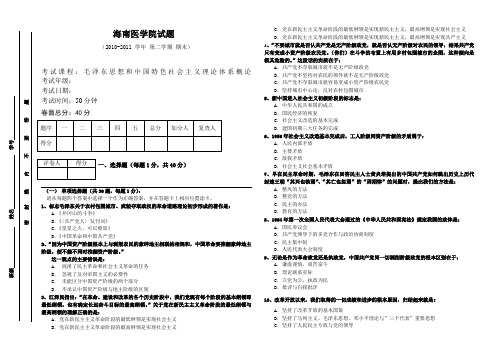
海南医学院试题(2010-2011 学年第二学期期末)考试课程:毛泽东思想和中国特色社会主义理论体系概论考试年级:考试日期:考试时间:50分钟卷面总分:40分一、选择题(每题1分,共40分)(一)单项选择题(共30题,每题1分):请从每题四个答案中选择一个作为正确答案,并在答题卡上相应位置涂卡。
1、标志毛泽东关于农村包围城市、武装夺取政权的革命道路理论初步形成的著作是:A.《井冈山的斗争》B.《〈共产党人〉发刊词》C.《星星之火,可以燎原》D.《中国革命和中国共产党》2、“因为中国资产阶级根本上与剥削农民的豪绅地主相联结相混和,中国革命要推翻豪绅地主阶级,便不能不同时推翻资产阶级。
”这一观点的主要错误是:A.混淆了民主革命和社会主义革命的任务B.忽视了反对帝国主义的必要性C.未能区分中国资产阶级的两个部分D.不承认中国资产阶级与地主阶级的区别3、江泽民指出:“在革命、建设和改革的各个历史阶段中,我们党既有每个阶段的基本纲领即最低纲领,也有确定长远奋斗目标的最高纲领。
”关于党在新民主主义革命阶段的最低纲领与最高纲领的理解正确的是:A.党在新民主主义革命阶段的最低纲领是实现社会主义B.党在新民主主义革命阶段的最高纲领是实现社会主义C.党在新民主主义革命阶段的最低纲领是实现新民主主义,最高纲领是实现社会主义D.党在新民主主义革命阶段的最低纲领是实现新民主主义,最高纲领是实现共产主义4、“不要城市就是否认共产党是无产阶级政党,就是否认无产阶级对农民的领导,结果共产党只有变成小资产阶级农民党。
(你们)在斗争的布置上有用乡村包围城市的企图,这种倾向是极其危险的。
”这段话的实质在于:A.共产党不夺取城市就不是无产阶级政党B.共产党不坚持对农民的领导就不是无产阶级政党C.共产党不夺取城市就容易变成小资产阶级农民党D.坚持城市中心论,反对农村包围城市5、新中国进入社会主义初级阶段的标志是:A.中华人民共和国的成立B.国民经济的恢复C.社会主义改造的基本完成D.建国初期三大任务的完成6、1956年社会主义改造基本完成后,工人阶级同资产阶级的矛盾属于:A.人民内部矛盾B.主要矛盾C.敌我矛盾D.社会主义社会基本矛盾7、早在民主革命时期,毛泽东在回答民主人士黄炎培提出的中国共产党如何跳出历史上历代封建王朝“其兴也勃焉”、“其亡也忽焉”的“周期律”的问题时,提出我们的方法是:A.整风的方法B.整党的方法C.民主的办法D.教育的方法8、1954年第一次全国人民代表大会通过的《中华人民共和国宪法》规定我国的政体是:A.国民参议会B.共产党领导下的多党合作与政治协商制度C.民主集中制D.人民代表大会制度9、无论是作为革命政党还是执政党,中国共产党同一切剥削阶级政党的根本区别在于:A.谦虚谨慎,艰苦奋斗B.理论联系实际C.立党为公,执政为民D.批评与自我批评10、改革开放以来,我们取得的一切成绩和进步的根本原因,归结起来就是:A.坚持了改革开放的基本国策B.坚持了马列主义、毛泽东思想、邓小平理论与”三个代表”重要思想C.坚持了人民民主专政与党的领导D.开辟了中国特色社会主义道路,形成了中国特色社会主义理论体系11、江泽民同志说:“邓小平同志这样说过:如果没有毛泽东同志,我们中国人民至少还要在黑暗中摸索更长的时间。
期末考试:现代材料测试分析方法及答案

期末考试:现代材料测试分析方法及答案一、引言本文旨在介绍现代材料测试分析方法,并提供相关。
现代材料测试分析方法是材料科学与工程领域的重要内容之一,它帮助我们了解材料的性质和特性,为材料的设计和应用提供依据。
本文将首先介绍几种常见的现代材料测试分析方法,然后给出相应的。
二、现代材料测试分析方法1. 机械性能测试方法机械性能是材料的重要指标之一,它包括材料的强度、硬度、韧性等方面。
常见的机械性能测试方法包括拉伸试验、压缩试验、冲击试验等。
这些测试方法通过施加外力或载荷,测量材料在不同条件下的变形和破坏行为,从而评估材料的机械性能。
2. 热性能测试方法热性能是材料在高温或低温条件下的表现,它包括热膨胀性、热导率、热稳定性等方面。
常见的热性能测试方法包括热膨胀试验、热导率测试、热分析等。
这些测试方法通过加热或冷却材料,测量其在不同温度下的性能变化,从而评估材料的热性能。
3. 化学性能测试方法化学性能是材料在不同化学环境中的表现,它包括耐腐蚀性、化学稳定性等方面。
常见的化学性能测试方法包括腐蚀试验、酸碱浸泡试验等。
这些测试方法通过将材料置于不同的化学介质中,观察其在化学环境下的变化,从而评估材料的化学性能。
三、1. 机械性能测试方法的应用机械性能测试方法广泛应用于材料工程领域。
例如,在汽车工业中,拉伸试验可以评估材料的抗拉强度和延伸性,从而选择合适的材料制造汽车零部件。
在建筑工程中,压缩试验可以评估材料的抗压强度,确保建筑结构的稳定性和安全性。
在航空航天领域,冲击试验可以评估材料的抗冲击性能,确保飞机在遭受外力冲击时不会破坏。
2. 热性能测试方法的意义热性能测试方法对于材料的设计和应用非常重要。
通过热膨胀试验,我们可以了解材料在高温条件下的膨胀性,从而避免热膨胀引起的构件变形和破坏。
通过热导率测试,我们可以评估材料的导热性能,为热传导设备的设计提供依据。
通过热分析,我们可以了解材料在不同温度下的热行为,为材料的热稳定性评估提供依据。
材料化学练习题
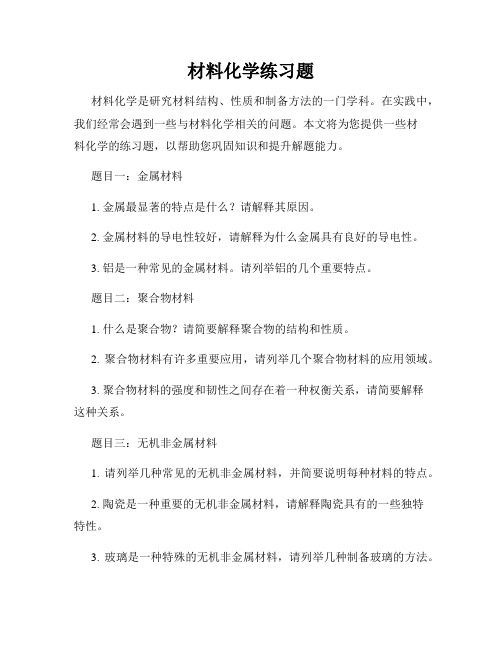
材料化学练习题材料化学是研究材料结构、性质和制备方法的一门学科。
在实践中,我们经常会遇到一些与材料化学相关的问题。
本文将为您提供一些材料化学的练习题,以帮助您巩固知识和提升解题能力。
题目一:金属材料1. 金属最显著的特点是什么?请解释其原因。
2. 金属材料的导电性较好,请解释为什么金属具有良好的导电性。
3. 铝是一种常见的金属材料。
请列举铝的几个重要特点。
题目二:聚合物材料1. 什么是聚合物?请简要解释聚合物的结构和性质。
2. 聚合物材料有许多重要应用,请列举几个聚合物材料的应用领域。
3. 聚合物材料的强度和韧性之间存在着一种权衡关系,请简要解释这种关系。
题目三:无机非金属材料1. 请列举几种常见的无机非金属材料,并简要说明每种材料的特点。
2. 陶瓷是一种重要的无机非金属材料,请解释陶瓷具有的一些独特特性。
3. 玻璃是一种特殊的无机非金属材料,请列举几种制备玻璃的方法。
题目四:材料分析方法1. 介绍一种常见的材料表征方法,并解释其原理。
2. X射线衍射(XRD)是一种常用的材料分析方法,请解释XRD 在材料研究中的应用。
3. 扫描电子显微镜(SEM)是一种常用的材料表征方法,请解释SEM的工作原理和应用。
题目五:材料制备方法1. 熔融法是一种常见的材料制备方法,请解释熔融法的基本原理和应用领域。
2. 沉积法是一种常用的材料制备方法,请解释沉积法的工作原理和几种常见的沉积法。
3. 气相沉积法是一种用于制备薄膜材料的方法,请解释气相沉积法的原理和应用。
题目六:材料性能测试1. 介绍一种常见的材料性能测试方法,并解释其原理。
2. 冲击试验是一种常用的材料性能测试方法,请解释冲击试验的原理和应用。
3. 硬度测试是一种常见的材料性能测试方法,请列举几种常用的硬度测试方法。
这些练习题涵盖了金属材料、聚合物材料、无机非金属材料、材料分析方法、材料制备方法以及材料性能测试等方面的知识点。
通过解答这些问题,您将能够更好地理解和应用材料化学的知识,提升自己的学习水平。
合成学期末考试试题及答案
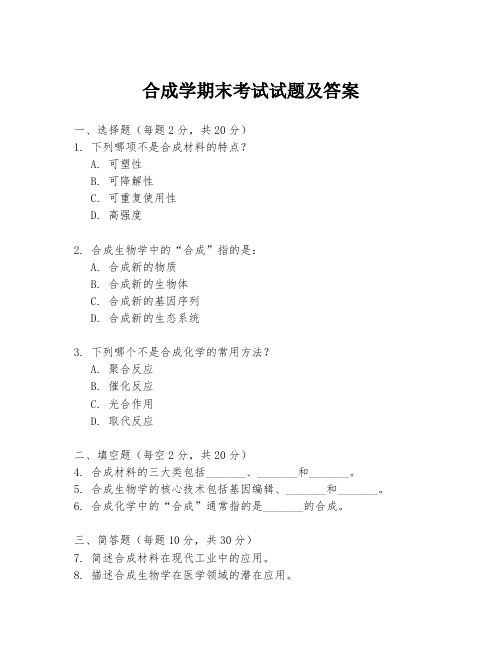
合成学期末考试试题及答案一、选择题(每题2分,共20分)1. 下列哪项不是合成材料的特点?A. 可塑性B. 可降解性C. 可重复使用性D. 高强度2. 合成生物学中的“合成”指的是:A. 合成新的物质B. 合成新的生物体C. 合成新的基因序列D. 合成新的生态系统3. 下列哪个不是合成化学的常用方法?A. 聚合反应B. 催化反应C. 光合作用D. 取代反应二、填空题(每空2分,共20分)4. 合成材料的三大类包括_______、_______和_______。
5. 合成生物学的核心技术包括基因编辑、_______和_______。
6. 合成化学中的“合成”通常指的是_______的合成。
三、简答题(每题10分,共30分)7. 简述合成材料在现代工业中的应用。
8. 描述合成生物学在医学领域的潜在应用。
9. 解释合成化学中“绿色化学”的概念及其重要性。
四、论述题(每题15分,共30分)10. 论述合成材料对环境可能产生的积极和消极影响。
11. 讨论合成生物学在伦理和法律方面的挑战。
五、案例分析题(10分)12. 阅读以下案例,并分析合成学在解决该问题中的作用及可能面临的挑战。
案例:随着全球塑料污染问题的日益严重,合成学如何帮助开发可降解的塑料替代品?答案一、选择题1. 答案:C(可重复使用性)2. 答案:C(合成新的基因序列)3. 答案:C(光合作用)二、填空题4. 答案:塑料、橡胶、纤维5. 答案:基因合成、细胞工程6. 答案:化学化合物三、简答题7. 答案:合成材料在现代工业中应用广泛,如汽车制造、建筑业、电子产品等领域,它们提供了高强度、轻质、耐腐蚀等特性,有助于提高产品性能和降低成本。
8. 答案:合成生物学在医学领域有多种潜在应用,包括开发新药、设计用于疾病治疗的生物传感器、以及通过基因编辑技术治疗遗传性疾病等。
9. 答案:绿色化学是一种减少或消除有害物质生成的化学实践,它强调从源头上预防污染,提高原料的利用效率,减少废物的产生,对环境保护具有重要意义。
2010-2023历年甘肃省秦安二中高一下学期期末考试历史试卷(带解析)

2010-2023历年甘肃省秦安二中高一下学期期末考试历史试卷(带解析)第1卷一.参考题库(共25题)1.关于布雷顿森林体系建立的表述,不正确的是()A.确立了美国世界经济霸主的地位B.标志着以美元为中心的国际货币金融体系建立C.确立了自由贸易体制D.一定程度上稳定了世界经济秩序2.《全球通史》中写道:“大危机中境况最惨的还是农业,农产品大量滞销,农民负债累累,农产品价格已跌到历史最低点,猪肉三分一磅,牛肉五分一磅,一只肥羊卖不到一元钱。
”罗斯福新政措施中,能够直接改变这一状况的是( ) A.减耕减产和调整产品结构B.控制物价与“以工代赈”C.实行救济和保护劳工权利D.增加工资与调整劳资关系3.“二战”后初期,在国际贸易中处于最强势地位的货币是()A.美元B.马克C.英镑D.欧元4.中国正式加入世贸组织是在( )A.1999年B.2000年C.2001年D.2002年5.从1912年至1919年,中国新建厂矿有600多家,其中发展最快的是纺织业和面粉业。
此外,火柴、榨油、造纸、化工等轻工业也发展迅速。
——摘自《中国近代现代史》可以看出中国民族资本主义经济蓬勃发展。
其特点是( )A.纺织业和面粉业发展最快B.以机器制造业带动全局C.东南沿海地区成为工商业中心D.中国工业产品大量出口6.罗荣渠在《现代化新论》中说:“1933年《申报月刊》发行‘中国现代化问题’特辑专号,征文中(26篇文章)认为中国现代化应走资本主义道路的观点非常少,绝大多数人主张走受节制的资本主义或非资本主义道路。
”产生上述认识主要是因为当时( )A.南京国民政府政策倡导B.资本主义在中国发展举步维艰C.西方经济危机危害严重D.马克思主义在中国被广为接受7.下列关于勃列日涅夫改革的表述,正确的是:()A.在社会主义国家中进行的最早B.没有摆脱斯大林模式的束缚C.只局限于农业领域D.没有取得任何成效8.罗斯福曾打比喻说:“1933年夏天,有位头戴丝绸帽子的老绅士在防波堤边上失足落水,他不会游泳。
青岛市2010年初中学业水平考试大纲解析
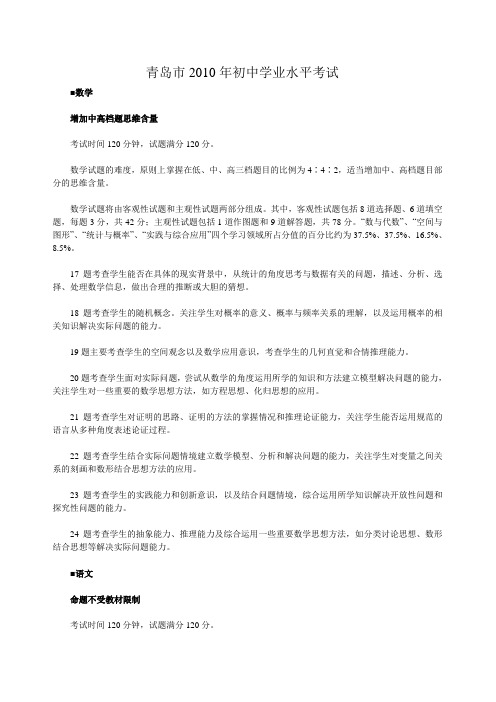
青岛市2010年初中学业水平考试■数学增加中高档题思维含量考试时间120分钟,试题满分120分。
数学试题的难度,原则上掌握在低、中、高三档题目的比例为4∶4∶2,适当增加中、高档题目部分的思维含量。
数学试题将由客观性试题和主观性试题两部分组成。
其中,客观性试题包括8道选择题、6道填空题,每题3分,共42分;主观性试题包括1道作图题和9道解答题,共78分。
“数与代数”、“空间与图形”、“统计与概率”、“实践与综合应用”四个学习领域所占分值的百分比约为37.5%、37.5%、16.5%、8.5%。
17题考查学生能否在具体的现实背景中,从统计的角度思考与数据有关的问题,描述、分析、选择、处理数学信息,做出合理的推断或大胆的猜想。
18题考查学生的随机概念。
关注学生对概率的意义、概率与频率关系的理解,以及运用概率的相关知识解决实际问题的能力。
19题主要考查学生的空间观念以及数学应用意识,考查学生的几何直觉和合情推理能力。
20题考查学生面对实际问题,尝试从数学的角度运用所学的知识和方法建立模型解决问题的能力,关注学生对一些重要的数学思想方法,如方程思想、化归思想的应用。
21题考查学生对证明的思路、证明的方法的掌握情况和推理论证能力,关注学生能否运用规范的语言从多种角度表述论证过程。
22题考查学生结合实际问题情境建立数学模型、分析和解决问题的能力,关注学生对变量之间关系的刻画和数形结合思想方法的应用。
23题考查学生的实践能力和创新意识,以及结合问题情境,综合运用所学知识解决开放性问题和探究性问题的能力。
24题考查学生的抽象能力、推理能力及综合运用一些重要数学思想方法,如分类讨论思想、数形结合思想等解决实际问题能力。
■语文命题不受教材限制考试时间120分钟,试题满分120分。
语文试题命题将不受语文教材的限制,不仅注重考查学生的语文知识、能力水平、基本语文素养,还要注重考查学生对语文学科知识的探究能力、对语文学科思想方法的理解能力以及综合运用语文知识分析和解决实际问题的能力。
中国近现代史材料分析题(附答案)
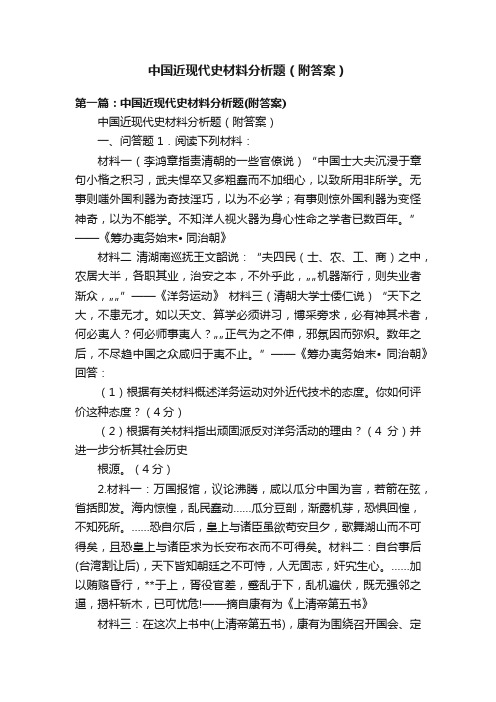
中国近现代史材料分析题(附答案)第一篇:中国近现代史材料分析题(附答案)中国近现代史材料分析题(附答案)一、问答题 1.阅读下列材料:材料一(李鸿章指责清朝的一些官僚说)“中国士大夫沉浸于章句小楷之积习,武夫悍卒又多粗蠢而不加细心,以致所用非所学。
无事则嗤外国利器为奇技淫巧,以为不必学;有事则惊外国利器为变怪神奇,以为不能学。
不知洋人视火器为身心性命之学者已数百年。
” ——《筹办夷务始末• 同治朝》材料二清湖南巡抚王文韶说:“夫四民(士、农、工、商)之中,农居大半,各职其业,治安之本,不外乎此,……机器渐行,则失业者渐众,……”——《洋务运动》材料三(清朝大学士倭仁说)“天下之大,不患无才。
如以天文、算学必须讲习,博采旁求,必有神其术者,何必夷人?何必师事夷人?……正气为之不伸,邪氛因而弥炽。
数年之后,不尽趋中国之众咸归于夷不止。
”——《筹办夷务始末• 同治朝》回答:(1)根据有关材料概述洋务运动对外近代技术的态度。
你如何评价这种态度?(4分)(2)根据有关材料指出顽固派反对洋务活动的理由?(4分)并进一步分析其社会历史根源。
(4分)2.材料一:万国报馆,议论沸腾,咸以瓜分中国为言,若箭在弦,省括即发。
海内惊惶,乱民蠢动……瓜分豆剖,渐露机芽,恐惧回惶,不知死所。
……恐自尔后,皇上与诸臣虽欲苟安旦夕,歌舞湖山而不可得矣,且恐皇上与诸臣求为长安布衣而不可得矣。
材料二:自台事后(台湾割让后),天下皆知朝廷之不可恃,人无固志,奸宄生心。
……加以贿赂昏行,**于上,胥役官差,蹙乱于下,乱机遍伏,既无强邻之逼,揭杆斩木,已可忧危!——摘自康有为《上清帝第五书》材料三:在这次上书中(上清帝第五书),康有为围绕召开国会、定宪法的主张,进一步提出变法的上、中、下三策。
皇帝仿效彼得大帝和明治天皇,亲自主持大计,宣布变法,是上策;召集有才能的人,共商变法的具体方案和步骤,依次推行,是中策;责成督抚在各省实施新政,……是下策。
2010年中国近现代史纲要期末考试复习试题1及答案
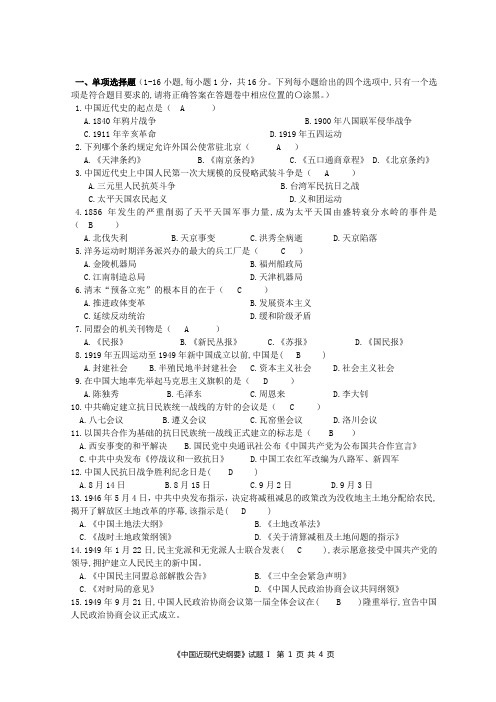
一、单项选择题(1-16小题,每小题1分,共16分。
下列每小题给出的四个选项中,只有一个选项是符合题目要求的,请将正确答案在答题卷中相应位置的〇涂黑。
)1.中国近代史的起点是( A )A.1840年鸦片战争B.1900年八国联军侵华战争C.1911年辛亥革命D.1919年五四运动2.下列哪个条约规定允许外国公使常驻北京( A )A.《天津条约》B.《南京条约》C.《五口通商章程》D.《北京条约》3.中国近代史上中国人民第一次大规模的反侵略武装斗争是( A )A.三元里人民抗英斗争B.台湾军民抗日之战C.太平天国农民起义D.义和团运动4.1856年发生的严重削弱了天平天国军事力量,成为太平天国由盛转衰分水岭的事件是( B )A.北伐失利B.天京事变C.洪秀全病逝D.天京陷落5.洋务运动时期洋务派兴办的最大的兵工厂是( C )A.金陵机器局B.福州船政局C.江南制造总局D.天津机器局6.清末“预备立宪”的根本目的在于( C )A.推进政体变革B.发展资本主义C.延续反动统治D.缓和阶级矛盾7.同盟会的机关刊物是( A )A.《民报》B.《新民丛报》C.《苏报》D.《国民报》8.1919年五四运动至1949年新中国成立以前,中国是( B )A.封建社会B.半殖民地半封建社会C.资本主义社会D.社会主义社会9.在中国大地率先举起马克思主义旗帜的是( D )A.陈独秀B.毛泽东C.周恩来D.李大钊10.中共确定建立抗日民族统一战线的方针的会议是( C )A.八七会议B.遵义会议C.瓦窑堡会议D.洛川会议11.以国共合作为基础的抗日民族统一战线正式建立的标志是( B )A.西安事变的和平解决B.国民党中央通讯社公布《中国共产党为公布国共合作宣言》C.中共中央发布《停战议和一致抗日》D.中国工农红军改编为八路军、新四军12.中国人民抗日战争胜利纪念日是( D )A.8月14日B.8月15日C.9月2日D.9月3日13.1946年5月4日,中共中央发布指示,决定将减租减息的政策改为没收地主土地分配给农民,揭开了解放区土地改革的序幕,该指示是( D )A.《中国土地法大纲》B.《土地改革法》C.《战时土地政策纲领》D.《关于清算减租及土地问题的指示》14.1949年1月22日,民主党派和无党派人士联合发表( C ),表示愿意接受中国共产党的领导,拥护建立人民民主的新中国。
现代材料分析测试题答案
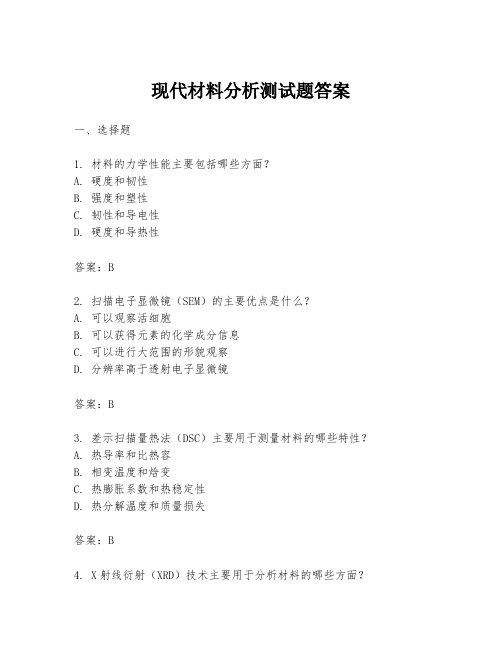
现代材料分析测试题答案一、选择题1. 材料的力学性能主要包括哪些方面?A. 硬度和韧性B. 强度和塑性C. 韧性和导电性D. 硬度和导热性答案:B2. 扫描电子显微镜(SEM)的主要优点是什么?A. 可以观察活细胞B. 可以获得元素的化学成分信息C. 可以进行大范围的形貌观察D. 分辨率高于透射电子显微镜答案:B3. 差示扫描量热法(DSC)主要用于测量材料的哪些特性?A. 热导率和比热容B. 相变温度和焓变C. 热膨胀系数和热稳定性D. 热分解温度和质量损失答案:B4. X射线衍射(XRD)技术主要用于分析材料的哪些方面?A. 晶体结构和晶格常数B. 表面形貌和元素分布C. 化学成分和热性能D. 力学性能和电学性能答案:A5. 拉曼光谱是一种非破坏性的分析手段,它主要用于分析材料的哪些特性?A. 晶体缺陷和杂质含量B. 分子结构和化学键振动C. 热稳定性和耐腐蚀性D. 电导率和磁性质答案:B二、填空题1. 材料的硬度是指材料抵抗__________的能力,而韧性是指材料在受到冲击或载荷作用时抵抗__________的能力。
答案:硬度;断裂2. 原子力显微镜(AFM)能够达到的横向分辨率可以达到__________,这使得它能够观察到单个原子或分子的结构。
答案:纳米级3. 动态机械分析(DMA)是一种用于测量材料在动态载荷下的__________和__________的分析技术。
答案:模量;阻尼4. 红外光谱(FTIR)可以用于分析材料中的__________和__________,从而获得材料的化学组成和结构信息。
答案:官能团;化学键5. 紫外-可见光谱(UV-Vis)主要用于分析材料的__________和__________,这对于研究材料的光学性质非常重要。
答案:吸收光谱;反射光谱三、简答题1. 简述材料的疲劳性能及其对工程应用的重要性。
答:材料的疲劳性能是指材料在循环载荷作用下抵抗裂纹形成和扩展的能力。
《科学与技术》期末考试试题与答案版

科学与技术复习试题一、选择题(每题2分,共10分)1.自然界中一切物体的相互作用,都可能归结为四种基本的相互作用,即引力、弹力、电磁力和(C)相互作用。
A.地磁力B.分子力C强力D.结合力2.基因是含特定遗传信息的核苷酸序列,是(D)的最小功能单位。
A .细胞B .蛋白质C .氨基酸D .遗传物质3.1996年,世界上第一只克隆羊——多利面世,这是世界上首次利用(A)技术而培养出的克隆动物。
A. 细胞核移植 B .细胞融合C.细胞培养 D .细胞膜嫁接4.由无数恒星和星际物质构成的巨大集合体称为(A)。
A.星系 B .星空 C .星云 D .星际5.光纤通信利用光纤来传送(C),它是20世纪70年代发展起来的一种新的通信方式。
A.电 B .声 C .光 D .机械二、填空题(每空2分,共10分)6.科学是技术发展的__理论__基础,技术是科学发展的手段,他们相互依存、相互渗透、相互转化。
7 .我国863计划中,被评选列入该纲要的8个技术群是生物技术、航天技术、信息技术、激光技术、自动化技术、能源技术、新材料技术和海洋技术。
8 .新技术革命的兴起是以__信息技术为先导的。
9.板块构造说的理论是在__大陆漂移学说、海底扩张学说的基础上发展起的。
10.1987年,世界环境与发展委员会发布了一份题为《我们共同的未来》的报告,首次提出了“可持续发展”的概念。
三、名词解释(每题5分,共20分)11.核能是在原子核变化过程中,从变化前后原子核质量亏损的质量差转化来的能量。
12. 纳米材料就是用特殊的方法将材料颗粒加工到纳米级(lo-g米),再用这种超细微粒子制造的材料。
13. 地球外部圈层结构指地球外部离地表平均800千米以内的圈层,包括大气圈、水圈和生物圈。
14 .物质生产力一(劳动者十劳动资料十劳动对象十管理+⋯⋯)高科技。
四、简答题(每题15分.共30分)15.简述科学认识发展的动因。
(1)科学认识发展的外部动因(8分)恩格斯曾经指出:“经济上的需要曾经是,而且越来越是对自然界的认识进展的主要动力”。
材料科学考试试题

材料科学考试试题
1. 问答题
1.1 介绍金属晶体的晶体系和点阵结构。
1.2 什么是晶体缺陷?列举并简要描述几种常见的晶体缺陷。
1.3 什么是金属材料的弹性变形?它的原理是什么?
2. 简答题
2.1 请解释热处理对金属的影响以及其应用。
2.2 介绍金属材料的断裂方式及其相关理论。
2.3 什么是塑性变形?请说明金属材料的塑性变形机制。
3. 计算题
3.1 某一种金属的密度为7.87 g/cm³,原子量为63.55。
计算该金属的晶格常数。
3.2 一个长度为2 cm,宽度为1 cm,高度为0.5 cm的金属样品,
质量为10 g。
以该金属的密度和弹性模量,计算其Young氏弹性模量。
3.3 一个拉伸试验样品的长度为200 mm,直径为10 mm,抗拉强
度为400 MPa。
计算其屈服强度。
4. 综合题
4.1 请以金属焊接为例,说明材料科学在工程应用中的重要性。
4.2 分析金属材料的导热性能和导电性能与其晶体结构的关系。
4.3 以金属腐蚀为例,探讨材料科学在延长金属材料使用寿命中的应用。
以上为材料科学考试试题,希望能够全面展示学生对材料科学基础知识的掌握和应用能力。
祝考生取得优异的成绩!。
- 1、下载文档前请自行甄别文档内容的完整性,平台不提供额外的编辑、内容补充、找答案等附加服务。
- 2、"仅部分预览"的文档,不可在线预览部分如存在完整性等问题,可反馈申请退款(可完整预览的文档不适用该条件!)。
- 3、如文档侵犯您的权益,请联系客服反馈,我们会尽快为您处理(人工客服工作时间:9:00-18:30)。
2010—2011 学年第一学期现代材料学试题(开卷)
(2010级研究生)
专业
姓名
学号
教学单位
考试日期2011-01-04
1. 说明一个面心正方结构相当于体心正方结
构。
氯化钠、氯化铯、金刚石都是立方晶系,
它们各属于那一种空间点阵?(10分)
2. 晶面)101(、)113(、)213(是否属于一个晶
带?如果是的话试指出其晶带轴,此外再指
出属于该晶带的任意一个其它晶面。
(10分)
3. 如下图所示,已知液、固相线均为直线,证明l
s w w k =0=常数;2)当0k =常数时,试证明液、固平面状临界条件()[]D k k mw R G 0001-=可简化为D T R G ∆=。
式中G 为温度梯度,R 为凝固速度,m 是液相线斜率,0w 是合金原始成分,D 是原子在液体中的扩散系数,0k 是平衡分配系数,21T T T -=∆。
(10分)
4. 面心立方金属孪生的1K 和2K 都是{}111
,在一个特定的{}111面,例如()111有几种产生孪晶的方法?写出它们的1η的方向指数。
(10分) 5. 设面心立方晶体中开动的滑移系是()111[]
101。
(10分)
a) 给出引起滑移的单位位错的b ,并说明之;
b) 若滑移是由纯刃位错移动引起的,给出位错线的方向;
c) 若滑移是由纯螺位错移动引起的,给出位错线的方向; d) 若作用在()111
[]
101的切应力为105Pa ,计算刃位错及螺位错单位位错线受力大小和方向(b=0.3nm )。
6. 简单立方晶体()100面有一个[]
010=b
的刃位错。
(10分)
a) 若在()001面上有一个[]010=b 的刃位错和它相割,发生位错扭折还是割阶?
b) 若在()001面上有一个[]100=b
的螺位错和它相割,发生位错扭折还是割阶? 7. 举例说明扩散规律在冶金生产过程和热处理工艺中的应用。
(10分)
8. 试分析晶界迁移的驱动力。
(10分)
9. 何谓调幅分解?它与形核长大这种脱溶方式有何异同之处?。
(10分)
10. 说明脱溶过程中过渡相出现的原因。
(
10分)。
